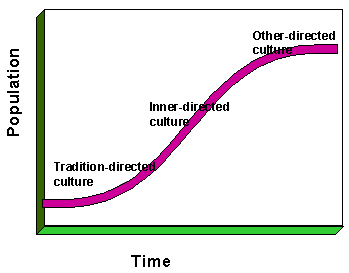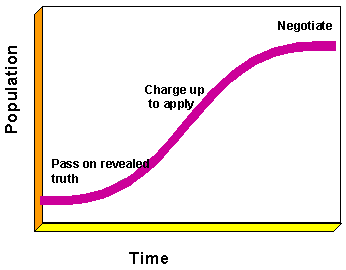Education and Culture
(Riesman
model)
In April 1997 the Harvard University Gazette reported,
"The journal Contemporary Sociology has named the best-selling
sociology book ever... The Lonely Crowd (Yale University
Press) by David Riesman, [with] Nathan Glazer, and Reuel Denney,
which the journal says has sold some 1.4 million copies since it
was published in 1950." Interestingly, if the web is anything
to go by, it is the fact of its popularity and influence which is
most remarked, rather than what it says.
I once met Riesman when I was an undergraduate, and he was a
visiting professor. That memory has not unduly influenced my respect
for his book, which could hardly be written today, so sweeping and
courageous is it in its scope. For me, its major claim to respect
is the way in which it predicted what is effectively the post-modern
movement and current culture. Commentators judge it in terms of
how right he was about '50s America, and say he exaggerated the
"social character" of the day: but he saw what was coming,
thirty-plus years ahead. There are not many texts which have been
so vindicated.
What follows is a sedimented account of the main
argument of the book, with particular reference to education. It
is "sedimented" in that it is what I remember of it�what
it has laid down in my psyche. So it is selective and perhaps too
neat, but the way to check that is to read it for yourself!
RIESMAN D, with GLAZER N and DENNEY R (1950) The Lonely Crowd: a study of the changing American character New Haven; Yale University Press (revised and abridged ed. Gitlin 1969)
Riesman starts from a demographic phenomenon�the "S-curve" of population growth as societies or countries become developed:

At the bottom of the curve, population is low, because in spite of a high birth-rate, there is a correspondigly high death-rate. Apart from infant mortality, life expectancy may typically be less than forty years. So population turnover is high.
The introduction of basic sanitation, limiting infectious diseases, and increasing control over environmental conditions leading to famine, sparks a period of rapid population growth as a country starts to develop. The birth-rate remains high, with the same large families which provided a defence against premature deaths, but the death-rate drops, so the population expands. As people come to expect children to survive to adulthood, family size slowly begins to drop. This occurred in the UK at the end of the 19th century and afterwards.
Eventually, the birth-rate drops to meet the death-rate, and perhaps below: population stabilises and may begin to decline. It appears at the time of writing that even China is on the cusp of this development.
But these changes do not happen in isolation: they are responses to changing economic circumstances:

The low population period is generally associated with a subsistence economy, in which each family or community is largely providing for itself, and external trade is limited. Population growth happens when change kicks in�as in the case of the industrial revolution. This marks the shift to a much more complex economy based on the production and sale of physical goods. Accompanying this stage is a process of accelerating change�not only economic and technological but also necessarily social and cultural.
The final stage in this model is a post-industrial society in which it is not the production of goods, but that of services such as education, transport, communications and health-care, and even leisure industries which come to dominate the economy. (There may of course be a later stage, but no-one has yet reached it, and Riesman was quite prescient in seeing this stage coming in the States in the late forties.)

So what kind of culture�or "social character", as Riesman put it�do you need in order to deal with these changing demographic and economic conditions?
When the world stays the same, but people come and go, the major task�he argues�is to maintain continuity. The wisdom of the past is the greatest resource, and so a "tradition-directed" culture develops. It holds together the transitory present community by adherence to the wisdom of the ancestors, and there is no premium on innovation.
When the world begins to change, however, culture faces a challenge. How to respond? Riesman suggests that the solution is what he calls "inner-directed" social character: the eternal verities of the past are valued and instilled into members of the community, in the confidence that as long as they hold to these basic principles in the face of change, the community will be preserved.
My image of this is that of a clockwork mouse. You wind it up (charge it with energy, or in this case values), put it down and it rushes off discharging that energy regardless of other circumstances. It accounts, for example, for the blithe indifference to local circumstances of British colonialists in the 19th century: their public-school education had led them to believe that there were certain ideal (i.e. British) values which were universally valid, so they dutifully�happily, even�exported them.
In the third stage, we have a long-lived population, surviving vast changes in economic, political, technological and social circumstances. The list of changes which have been experienced by a pensioner of today would fill several volumes, and change is accelerating. What kind of culture (social character) can cope with that? The past is no longer viable as a reference point: instead we turn to each other, and take our cues from current discourse. At its most basic, this "other-directed" character is based on fashion and acceptability.
Riesman goes on to plead for a different kind of social character�"autonomy"�which eschews fashion in favour of making up one's own mind about things in a principled and Enlightenment kind of way. This part of the book carries less conviction than his earlier trenchant analysis.
The epitome of inner-directed social character is to be found in Newbolt's poem "Vitai Lampada". See also this commentary on its context

So what kind of education follows from these stages? Armstrong (2001) succinctly expresses the tradition-directed approach in the context of Muslim education, but as she says, it is not restricted to the Islamic world:
-
"...the conservatism that always characterized
agrarian society. When resources were limited, it was impossible
to encourage inventiveness and originality in the way that we
do today in the modern West, where we expect to know more than
our parents' generation and that our children will experience
still greater advance. [...] in all pre-modern societies,
including that of agrarian Europe, education was designed to
preserve what had already been achieved and to put a brake on
the ingenuity and curiosity of the individual, which could undermine
the stability of a community that had no means of integrating
or exploiting fresh insights. In the madrasahs, for example,
pupils learned old texts and commentaries by heart, and the
teaching consisted of a word-by-word explication of a standard
textbook. Public disputations between scholars took it for granted
that one of the debaters was right and the other wrong. There
was no idea, in the question-and-answer style of study, of allowing
the clash of two opposing positions to build a new synthesis.
Armstrong (2001) pp. 87-88
There was an expectation in such tradition-directed education that the old learning was just as valid today as ever in the past. The inner-directed model recognises change in the world, and consequently moves to a more abstract set of values, but clings to ideas of objective truth and eternal values: it is what we would readily recognise as conservative education today. Thus the efforts of Dr Arnold at Rugby School, or the present concerns about whether pupils should be inducted into the canon of English literature (and what that consists of), all represent aspects of inner-directed educational philosophy. Central to it is the authority of the teacher, and as another paper explores, educational technologies and even classroom layout are implicated in this debate.
On the other side of this argument is other-directed education, fuelled by post-modernism and humanistic educational theory. As a motivator, competition is replaced by collaboration; the role of the teacher becomes facilitative rather than authoritative; critical thinking becomes more important than knowledge itself. Hence inner-directed "standards" may be seen as sacrificed to "relevance" and "currency". Is it dumbing down? How does formal education stand in relation to all the other media which are playing an increasing role in forming and informing the coming generations? As a commentator remarked, the current world-view may be "post" modernist, but what is it "pre"?
The Riesman model provides a sweeping and perhaps crude way of locating not only the values of education but also those of politics and even art, within a process in which different countries and regions are at different stages, driven by linked economic and technological imperatives�it is a tool for understanding the "clash of civilizations". But, apart from his call for "autonomy" it does not provide any answers.
ARMSTRONG, K (2001) Islam: a short history London; Phoenix
HARGREAVES A (1994) Changing Teachers, Changing Times London; Cassell
HUNTINGTON S P (1997) The Clash of Civilizations and the Remaking of World Order New York; Simon and Schuster
Atherton J S (2013) Doceo; [On-line: UK] retrieved from
Original
material by James Atherton: last up-dated overall 10 February 2013 
This work is licensed under a Creative Commons Attribution-Noncommercial-No Derivative Works 3.0 Unported License.
Search Doceo and associated sites:
![]() Save this on Delicious Tweet
Save this on Delicious Tweet
 Click
here to send to a friend
Click
here to send to a friend
This site is independent and self-funded. The site does not accept advertising or sponsorship (apart from what I am lumbered with on the reports from the site Search facility above), and invitations/proposals/demands will be ignored, as will SEO spam. I am not responsible for the content of any external links; any endorsement is on the basis only of my quixotic judgement. Suggestions for new pages and corrections of errors or reasonable disagreements are of course always welcome.
